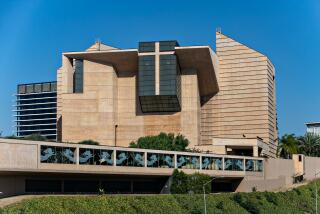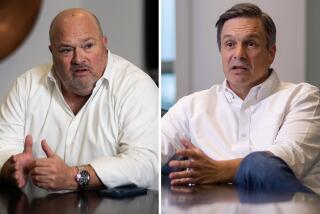Priest in Abuse Scandal Defrocked
- Share via
BOSTON — The Roman Catholic Archdiocese announced Thursday that Paul R. Shanley, one of the most notorious figures in the Boston clerical sex abuse scandal, had been removed from the priesthood.
The rarely used process of laicization -- known colloquially as being defrocked -- is among the most extreme punishments the Vatican can invoke, stripping a priest of his job and ending the lifelong benefits that come with the position.
“This letter serves as a formal communication of your dismissal from the clerical state by the Holy Father,” wrote Boston Archbishop Sean Patrick O’Malley in a Monday missive.
The letter also informed Ronald H. Paquin, who is in prison for raping a 12-year-old boy, that he was no longer a priest.
A spokesman for the Boston Archdiocese, Father Christopher Coyne, said Pope John Paul II made the decision to dismiss Shanley on Feb. 19. As a result, Coyne said Thursday, Shanley and Paquin were “no longer to be referred to as a priest nor to exercise sacramental ministry.”
Shanley was a popular, motorcycle-riding “street priest” in Boston in the 1960s and 1970s, known for his work with gay and troubled youth. He is scheduled to stand trial here in October on 10 counts of child rape, as well as a series of related criminal charges. He has pleaded not guilty.
The 73-year-old former priest was arrested in May 2002 in San Diego, where he had been living in retirement. Shanley also had served parishes in San Bernardino in the 1990s -- after his alleged crimes in New England took place. Cardinal Bernard Law, the then-archbishop of Boston, vouched for his character and recommended the transfer.
Shanley was released on $300,000 bail in December 2002. He lived for a time in Provincetown, Mass., a popular vacation resort for gays and lesbians on Cape Cod, and moved recently to the Massachusetts seaside town of Marion.
Rodney Ford, whose son Gregory was among Shanley’s alleged victims, on Thursday welcomed the Vatican’s decision to remove him from the priesthood.
“It was inevitable that it was going to happen,” Ford said in an interview. “He is a very vicious and sick individual. And he has been collecting benefits right up until today. This is long overdue.”
Gregory Ford, 26, has said that Shanley molested him repeatedly at a parish in Newton, Mass., beginning when he was 6 years old. He said the abuse continued for five years.
Three weeks ago, Ford accepted a settlement from the Boston Archdiocese estimated at more than $1 million.
Photographs of Ford as a smiling 5-year-old were featured two years ago in a presentation prepared by his lawyer, Roderick MacLeish Jr., in which previously secret church documents pointing to Shanley’s alleged crimes were released.
During the same presentation, Shanley was revealed to have been active in NAMBLA, the North American Man-Boy Love Assn., and to have advocated sex between adults and children.
The disclosures helped bring about a criminal investigation of Shanley.
Soon after, the sexual abuse crisis that had been festering in the Roman Catholic Church in Boston spread across the country and around the world.
As was the case with Shanley, formerly secret documents showed that the church in many cases had been aware that priests were molesting children. Rather than being removed from their work, priests routinely were reassigned by church officials to other parishes -- a tactic known internally as “the geographic cure.”
The church also sponsored psychological treatment for many priests charged with abusing children, only to return them to parish work when the treatment was concluded.
Hundreds of priests and at least three bishops nationwide have been removed from their duties as a result of the scandal.
Church settlements with abuse victims around the country have totaled hundreds of millions of dollars. The Boston Archdiocese reached an $85-million settlement last year with more than 500 men and women who said they had been abused.
Informed Thursday in St. Louis of Shanley’s laicization, David Clohessy -- a founder of the Survivors Network for Those Abused by Priests -- said the action was “long overdue.”
Shanley’s lawyer, Frank Mondano, did not respond Thursday to a request for comment.
MacLeish’s law partner, Jeffrey Newman, said Thursday that their firm represented about 20 people who allegedly had been abused by Shanley. Newman said the final civil settlements in those cases came three weeks ago.
“It was critical that we see the church take this step. Otherwise, it would be a constant source of pain for these people, knowing that the church had maintained him in the priesthood even though the church was aware from its own files that he had molested children,” Newman said.
“To have the pope sign on the dotted line, to say that this man is no longer a priest, that he has violated every vow he took -- that is a major thing for our clients.”
Boston College theology professor Stephen Pope on Thursday characterized laicization as “a pretty extreme move, and it is very rare.”
But in the case of Shanley, he said, “It doesn’t surprise me. Shanley’s crimes are grievous. He was a serial abuser. He violated everything that Catholic priesthood stands for. He also went even further, arguing that his deviant behavior was acceptable.
“If he is not defrocked, who would be?” Pope added. “He is a poster boy for who should be defrocked.”
Priests are ordained for life, said another Boston College theology professor and former priest, Thomas Groome, who voluntarily left the church. And defrocking a priest, Groome said, was “the way the Catholic Church has of saying to the world, we no longer recognize this person as a priest. And once it is done, there is no appeal. When the pope says it or does it, that’s it.”
Rodney Ford said Thursday that no one in his family would celebrate Shanley’s laicization.
“Celebrating is never a word that we can use in the Catholic abuse crisis,” he said.










